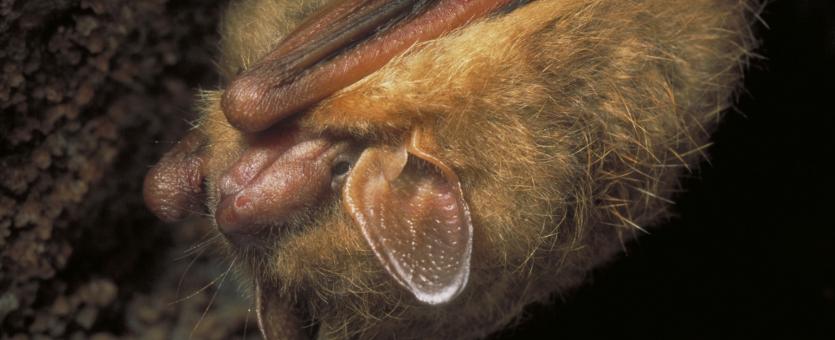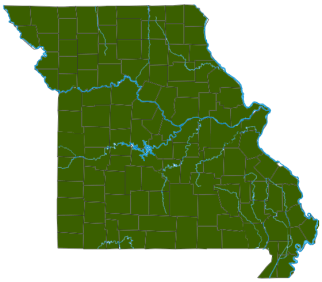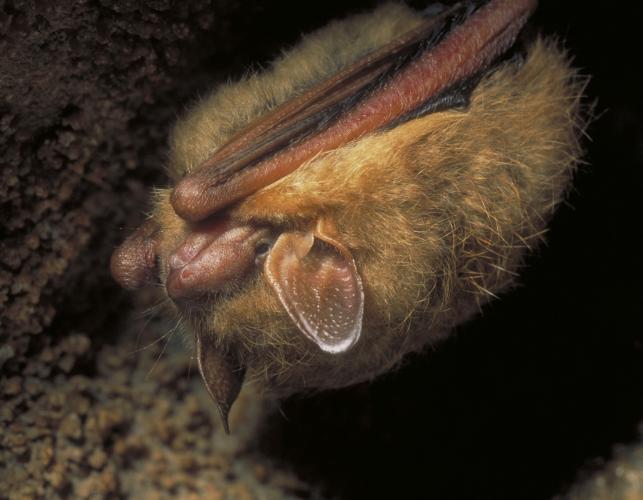
Tri-colored bats, formerly called eastern pipistrelles, are relatively small and overall look pale yellowish or pale reddish brown. The main hairs, when separated by blowing into the fur, are seen to be dark gray at the base, then broadly banded with yellowish brown, and tipped with dark brown; the three-colored hairs explain the name "tri-colored bat." In caves, they are often covered with dew drops. This species is usually found roosting singly, sometimes in pairs, and rarely in clusters of up to a few to a dozen bats. The forearms are distinctly pink and contrast strongly with the black wing membranes. Ears are small, and the tip of the tragus (the roughly triangular structure in front of the ear hole) is rounded. They posture typically appears hunched or rounded. They are common in winter.
Total length: 3–3½ inches; tail length: 1½–1¾ inches; weight: 1/10–2/7 ounces (2–8 g).

Statewide.
Habitat and Conservation
Bats of this species can be found hibernating singly in most caves in Missouri. In our state, most tri-colored bats hibernate in winter in the most humid and warm parts of caves. In summer, they roost in trees, in crannies about cliffs or buildings, in barns, or sometimes in high domes of caves. Do not disturb roosting bats, and do not handle them. One of the few kinds of mammals that people can watch, bats have suffered from misinformation and superstition for years.
BATS AND COVID-19: There is no evidence that Missouri bats have COVID-19 (SARS-CoV02), the virus that is causing the human pandemic. All viruses that have been identified in U.S. bats are alphacoronaviruses, while COVID-19 is a betacoronavirus. MDC, the U.S. Fish and Wildlife Service, and the Association of Fish and Wildlife Agencies are concerned about the possibility of bats contracting the COVID-19 virus from infected humans. Until more information is available, no activities that result in the direct interaction with live wild bats or with MDC-owned caves are permitted under existing or new 2020 Wildlife Collector Permits at this time. To protect bats, people are advised to not interact with them.
Food
This small bat feeds on tiny insects, particularly flies, moths, wasps, leafhoppers, and beetles, many of which are aquatic forms. Compared to other bats, tri-colored bats appear weak fliers, flying with a fluttering motion in an undulating course. They begin feeding about sundown, with other feeding periods toward midnight and near daylight. They generally forage high over watercourses at the forest edge.
Status
Common, but declining.
Life Cycle
Mating occurs in fall, intermittently throughout winter, and again in spring. Relatively small maternity colonies start forming in mid-April. The 1 or 2 (rarely 3) young are born from late May to mid-July, after a gestation period of at least 44–60 days. The young are able to fly at about 4 weeks of age. They probably do not mate in the year of their birth.
Control
Human Connections
Bats help control insects, some of which are agricultural pests or are annoying to people (such as mosquitoes). Bats have contributed much to human knowledge through scientific studies of their echolocation, biology, and physiology. Bats are protected by both state and federal laws.
Ecosystem Connections
As predators, bats help to hold insect populations in balance; also, many forms of cave-dwelling life depend on the nutrients brought in by bats and released from their guano (feces). The only mammals capable of true flight, bats are greatly important in the natural scheme of things.























